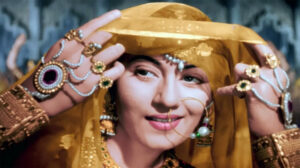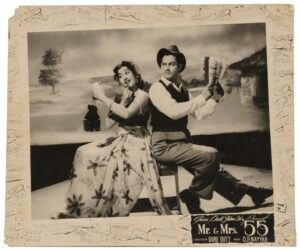
‘The biggest star in the world . . . and she’s not in Beverly Hills’, as David Cort titled his celebratory dedication in Theatre Arts Magazine (1952) to prophesise the superstardom of this dedicatee: a vivacious, versatile actor from Bombay, India, who would go to become one of the most iconic and cherished actors/superstars India had ever witnessed.
Following the ranks of untarnished eminence that had been occupied by contemporaries like Nargis, Meena Kumari, and Suraiya, Madhubala emerged from the deeper heavens, a blazing emerald, and shook the foundations of Hindustani/Bombay Cinema, shifting gender and sexual paradigms, ergo introducing an unfamiliar poignancy in feminine representations that wasn’t either deemed realistic or even attempted/speculated by the brave hearts of directors–producers. These exo–cinematic shifts and traditions strengthened the growth of eclectic women–within–film and were continued by people like Raj Kapoor, Vyjayanthimala, Helen, Zeenat Aman and Smita Patil until the mid–80s; and these were also clearly apparent in Madhubala’s artistry and cinematic styles. Her choice of filmic–genres was vividly diverse and included historicals/chronicles, romantic comedies, socials/social romances, horrors/thrillers, and even tragedies. It was, indeed, an exceptional feat to achieve – especially during a time when stars/actors were soon typecast to complement the audiences’ tastes and preferences. However, I still believe that Madhubala outshone the most in socials, comedies, and chronicles like Hanste Aansoo (1950), Mr. and Mrs. ‘55 (1955), and Mughal–e–Azam (1960), respectively, wherein her natural urbanity and vivacity were seamlessly positioned and weren’t lost in characterisations. She deployed her theatrical rawness for its cinematic projections, and her bold demeanours attributed themselves as desirable add-ons, making her the most sought–after actor between 1949 – 1960.
Unfortunately, her career was cut short by the diagnosis of a congenital ventricular septal defect, worsening her health in 1960 and simultaneously affecting her humongous acting career before taking her away in 1969 at 36. She finally appeared in Jwala (1971), albeit posthumously.
Nonetheless, despite an early adieu and, supposedly, becoming a target of professional politics and peer indifference – the latter exemplifies itself by the entertainment industry’s absolute disinterest in celebrating and acknowledging Madhubala’s talents and contributions to films, which grows into perpetual exasperation on being reminded about Bina Rai’s 1961 win for Ghunghat at the 8th Filmfare Awards, when she outweighed the former’s landmarking and legendary performance in K. Asif’s magnum opus, Mughal–e–Azam – Madhubala retained her position in the sociocultural memory of India, still enjoying its immortal fascination and love for a figure that the country had never witnessed before, and might not experience ever again.
Undoubtedly a super superstar, Madhubala embodied the idea of ‘being iconic’. She displayed a scintillating form of uniqueness and iconoclasm that was at once powerful, brave, calming, dangerous, and unexpected, helping her become a memorable chapter in the history of cinema that many of us must have wanted to be part of. Such was Madhubala’s charisma . . .


